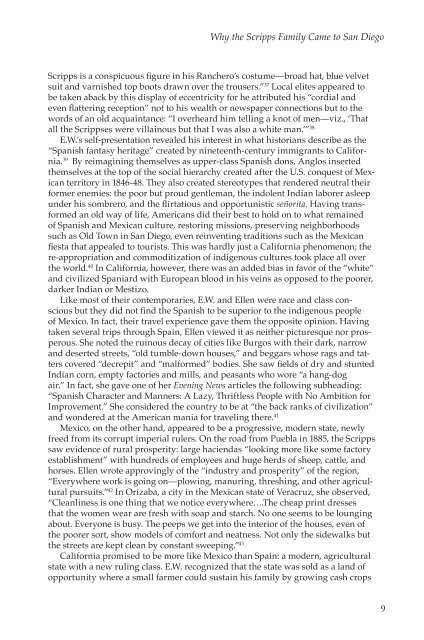You also want an ePaper? Increase the reach of your titles
YUMPU automatically turns print PDFs into web optimized ePapers that Google loves.
Why the Scripps Family Came to <strong>San</strong> <strong>Diego</strong><br />
Scripps is a conspicuous figure in his Ranchero’s costume—broad hat, blue velvet<br />
suit and varnished top boots drawn over the trousers.” 37 Local elites appeared to<br />
be taken aback by this display of eccentricity for he attributed his “cordial and<br />
even flattering reception” not to his wealth or newspaper connections but to the<br />
words of an old acquaintance: “I overheard him telling a knot of men—viz., ‘That<br />
all the Scrippses were villainous but that I was also a white man.’” 38<br />
E.W.’s self-presentation revealed his interest in what historians describe as the<br />
“Spanish fantasy heritage” created by nineteenth-century immigrants to California.<br />
39 By reimagining themselves as upper-class Spanish dons, Anglos inserted<br />
themselves at the top of the social hierarchy created after the U.S. conquest of Mexican<br />
territory in 1846-48. They also created stereotypes that rendered neutral their<br />
former enemies: the poor but proud gentleman, the indolent Indian laborer asleep<br />
under his sombrero, and the flirtatious and opportunistic señorita. Having transformed<br />
an old way of life, Americans did their best to hold on to what remained<br />
of Spanish and Mexican culture, restoring missions, preserving neighborhoods<br />
such as Old Town in <strong>San</strong> <strong>Diego</strong>, even reinventing traditions such as the Mexican<br />
fiesta that appealed to tourists. This was hardly just a California phenomenon; the<br />
re-appropriation and commoditization of indigenous cultures took place all over<br />
the world. 40 In California, however, there was an added bias in favor of the “white”<br />
and civilized Spaniard with European blood in his veins as opposed to the poorer,<br />
darker Indian or Mestizo.<br />
Like most of their contemporaries, E.W. and Ellen were race and class conscious<br />
but they did not find the Spanish to be superior to the indigenous people<br />
of Mexico. In fact, their travel experience gave them the opposite opinion. Having<br />
taken several trips through Spain, Ellen viewed it as neither picturesque nor prosperous.<br />
She noted the ruinous decay of cities like Burgos with their dark, narrow<br />
and deserted streets, “old tumble-down houses,” and beggars whose rags and tatters<br />
covered “decrepit” and “malformed” bodies. She saw fields of dry and stunted<br />
Indian corn, empty factories and mills, and peasants who wore “a hang-dog<br />
air.” In fact, she gave one of her Evening News articles the following subheading:<br />
“Spanish Character and Manners: A Lazy, Thriftless People with No Ambition for<br />
Improvement.” She considered the country to be at “the back ranks of civilization”<br />
and wondered at the American mania for traveling there. 41<br />
Mexico, on the other hand, appeared to be a progressive, modern state, newly<br />
freed from its corrupt imperial rulers. On the road from Puebla in 1885, the Scripps<br />
saw evidence of rural prosperity: large haciendas “looking more like some factory<br />
establishment” with hundreds of employees and huge herds of sheep, cattle, and<br />
horses. Ellen wrote approvingly of the “industry and prosperity” of the region,<br />
“Everywhere work is going on—plowing, manuring, threshing, and other agricultural<br />
pursuits.” 42 In Orizaba, a city in the Mexican state of Veracruz, she observed,<br />
“Cleanliness is one thing that we notice everywhere….The cheap print dresses<br />
that the women wear are fresh with soap and starch. No one seems to be lounging<br />
about. Everyone is busy. The peeps we get into the interior of the houses, even of<br />
the poorer sort, show models of comfort and neatness. Not only the sidewalks but<br />
the streets are kept clean by constant sweeping.” 43<br />
California promised to be more like Mexico than Spain: a modern, agricultural<br />
state with a new ruling class. E.W. recognized that the state was sold as a land of<br />
opportunity where a small farmer could sustain his family by growing cash crops<br />
9







![[PDF] The Journal of San Diego History Vol 52: Nos 1 & 2](https://img.yumpu.com/25984149/1/172x260/pdf-the-journal-of-san-diego-history-vol-52-nos-1-2.jpg?quality=85)

![[PDF] The Journal of San Diego History - San Diego History Center](https://img.yumpu.com/25984131/1/172x260/pdf-the-journal-of-san-diego-history-san-diego-history-center.jpg?quality=85)






